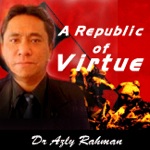On “Singapore Maths” and world-class education

Essentially the Singapore Malays, arguably have learned the meaning of affirmative action and meritocracy well. The idea of “Mendaki” as a means to help the academically underachieving Malays in the city-state is admirable, perceived from an educational standpoint.
A REPUBLIC OF VIRTUE
Azly Rahman
The article below, from The Seattle Times and which was linked to the online publication of the National Educational Association (NEA) should be of interest to Malaysian educators teaching Mathematics.
Costructivism as a paradigm of teaching and learning has been around for quite some time and infused in many a school in the advanced countries. Constructivism is drawn from the work of Socrates, Piaget, and Brain Science theorists. It is essentially Deweyian in philosophy as well..
The superiority of the Singapore education system is something the Singaporeans have worked hard to build.
Essentially the Singapore Malays, arguably have learned the meaning of affirmative action and meritocracy well. The idea of “Mendaki” as a means to help the academically underachieving Malays in the city-state is admirable, perceived from an educational standpoint. Born in Alexander Road Singapore and growing up in Johor Bahru, I have always been fascinated by the way the Singaporeans run their city-state. As a teenager , I spend my weekends roaming the streets of Singapore, fascinated by the buildings, the food stalls, the bargain stores, the movie theaters, and how law is enforced.
Political and historical ego aside, Malaysian educationists must start looking across the causeway to find solutions to the educational system that needs constant improvement.
We have a world-class education system in our neighbour.
The secret of Schmitz Park Elementary School is Singapore Math
One elementary school in Seattle — Schmitz Park Elementary — bucks the trend toward reform or constructivist math by offering Singapore Math, writes Seattle Times columnist Bruce Ramsey
By Bruce Ramsey
Seattle Times editorial columnist
Sally made 500 gingerbread men. She sold 3/4 of them and gave away 2/5 of the remainder. How many did she give away?
This was one of the homework questions in Craig Parsley’s fifth-grade class. The kids are showing their answers on the overhead projector. They are in a fun mood, using class nicknames. First up is “Crackle,” a boy. The class hears from “Caveman,” “Annapurna,” “Shortcut” and “Fred,” a girl.
Each has drawn a ruler with segments labeled by number — on the problem above, “3/4,” “2/5” and “500.” Below the ruler is some arithmetic and an answer.
“Who has this as a single mathematical expression? Who has the guts?” Parsley asks. No one, yet — but they will.
This is not the way math is taught in other Seattle public schools. It is Singapore Math, adopted from the Asian city-state whose kids test at the top of the world. Since the 2007-08 year, Singapore Math has been taught at Schmitz Park Elementary in West Seattle — and only there in the district.
In the war over school math — in which a judge recently ordered Seattle Public Schools to redo its choice of high-school math — Schmitz Park is a redoubt or, it hopes, a beachhead. North Beach is a redoubt for Saxon Math, a traditional program. Both schools have permission to be different. The rest of the district’s elementary schools use Everyday Math, a curriculum influenced by the constructivist or reform methods.
Reform math is known for several things. Instead of showing kids how to solve a problem, which Singapore Math does, reform math has them work in groups to discover ways to solve it. It wants them to explain how they did it, sometimes using a special vocabulary.
Sabrina Kovacs-Storlie, a supplemental math teacher at Schmitz Park, taught reform math for several years. “It is full of words,” she says. “So many words.”
Reform math also aims at exposing kids to advanced concepts at an early age. As a result, it jumps around. Kovacs-Storlie opens an Everyday Math book. Here is a lesson on calculating the perimeter of a shape. Next is a lesson about probability.
“It is teaching to exposure,” she says. “We are teaching to mastery.”
Schmitz Park’s curriculum is more like the math parents remember. They came out big for Math Night a few weeks ago. Their PTA pays for the Singapore books — and also for Kovacs-Storlie’s salary.
Test results are encouraging. At Schmitz Park, 86 percent of the fifth-graders passed the WASL test in math, compared with 68 percent districtwide. At Schmitz Park, 67 percent passed with a Level 4 (high) result. Seattle schools have different mixes of kids and show a wide variation in math scores. Some schools did better than Schmitz Park. Most did worse.
Curriculum is not the only factor. Another is the enthusiasm of the teachers, which Garrit Kischner, Schmitz Park’s principal, says this curriculum has. Being among rebels, and having to prove something, can be invigorating.
The kids sense it, too. One of the girls in Parsley’s class says proudly that hers is the only school in Seattle with this math.
Next year, these kids will be at Madison Middle School. They will have the reform math. Kathleen Myers, who teaches sixth-grade math there, says the Schmitz Park kids will do all right. They are very good at solving problems.
Of the Schmitz Park curriculum, she says, “I’m happy with it.” Two of her kids are there.
SOURCE: http://seattletimes.nwsource.com/html/opinion/2011097718_bruce17.html?prmid=op_ed
OUR USUAL REMINDER, FOLKS:
While the opinion in the article is mine,
the comments are yours;
present them rationally and ethically.
AND — ABOLISH THE ISA — NOW!
on facebook: http://www.facebook.com/people/Azly-Rahman/689079971
on twitter: http://twitter.com/azlyrahman
on blog: http://azlyrahman-illuminations.blogspot.com/

